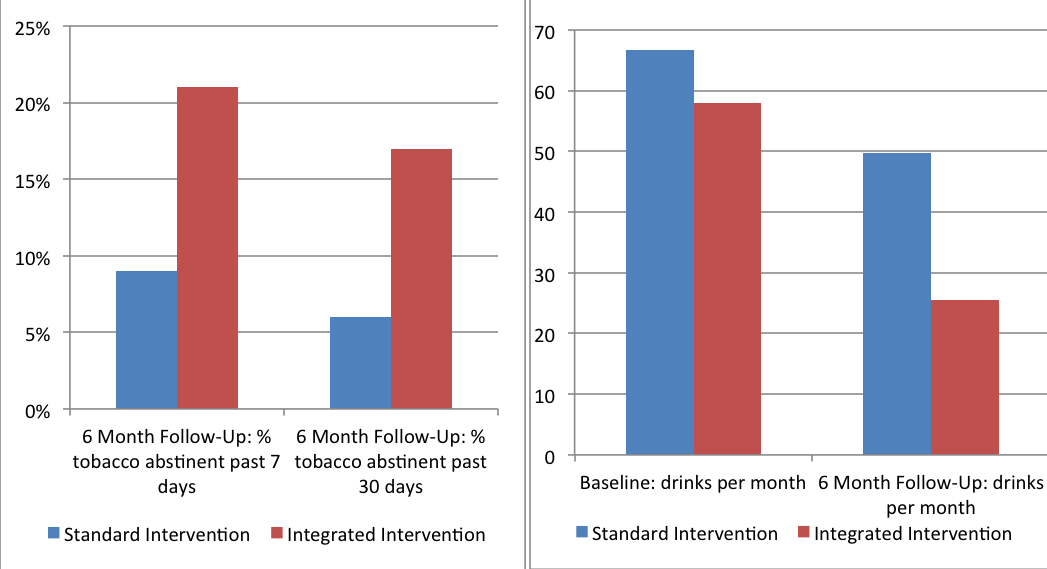ASHES, Vol. 11(4): Integrated intervention: Reducing both smoking and heavy drinking among young adults
Both cigarette smoking and excessive drinking behavior are prevalent among young adults. In non-college populations, 34% of young adults between age 18 and 22 smoke and 33% report binge drinking. In college populations, 21% smoke and 39% report binge drinking (Substance Abuse and Mental Health Services Administration, 2014). Smoking patterns among young adults differ from those in adult populations, and are often tied closely to their drinking patterns. However, few interventions have targeted the young adult population. This week’s ASHES, part of our Special Series on Alcohol Awareness Month, reviews a study by Ames and colleagues (2014) that tested an intervention for young adults that targets both drinking and smoking behavior.
Methods
- Researchers recruited 95 participants who were interested in stopping smoking from college campuses and public places in two northern Florida communities. Participants were between 18 and 30, smoked at least one cigarette per day, and reported at least one binge drinking episode per month in the past three months.
- All participants received a smoking cessation intervention, delivered as 30-minute sessions once per week for six weeks, as well as nicotine patch therapy, initiated on week 4 of the treatment and continued for eight weeks (i.e., standard intervention).
- Through random assignment, half of participants also received intervention for binge drinking as part of their smoking cessation sessions (i.e., integrated intervention).
- For both groups, researchers assessed the following measures at the beginning of treatment, the end of treatment, and 6 months after treatment:
- Self-report of tobacco use in the past 7 days and past 30 days, confirmed via biochemical markers (assessed at end of treatment and 6 months);
- Self-report of past 30-day quantity and frequency of alcohol use and binge drinking (assessed at beginning of treatment and 6 months);
- Perceived similarity to other smokers (assessed at beginning of treatment and 6 months);
- Self-reported smoking cravings (assessed at beginning of treatment and 6 months);
- Self-efficacy to stop smoking (assessed at beginning of treatment and 6 months).
Results
- Participants who received the integrated intervention had higher rates of tobacco abstinence at the end of treatment and 6 months after study entry (see Figure 1) than participants who received the standard intervention. Still, fewer than 25% of all participants had stopped smoking by the 6-month follow-up.
- Participants who received the integrated intervention decreased their number of drinks per month (see Figure 1) and binge drinking more than participants in the standard intervention.
- Participants reported fewer cravings, better self-efficacy to stop smoking, and less similarity to other smokers at the end of treatment, compared to baseline; there were no differences between interventions.
Figure 1. Tobacco abstinence and changes in drinking behavior post-intervention (adapted from Ames et al., 2014.) Click image to enlarge.
Limitations
- The study used a convenience sample, recruited from people who were interested in changing their smoking behavior and happened to frequent the locations where study recruitment took place; these participants might not be representative of all young adults who want to stop smoking.
- Analyses that included 6 month follow-up data were based only on the participants who completed the study. Fewer than 50% of participants completed the study; these individuals might have differed systematically from those who did not complete the study.
Conclusions
The results of this study suggest that an integrated intervention that addresses both smoking behavior and drinking behavior has promising results among young adults. Importantly, though smoking cessation rates were modest, the addition of the drinking intervention appeared to strengthen the effect of the intervention on smoking behavior. This confirms research suggesting that among young adults, smoking is often closely connected to drinking behavior and contexts in which drinking occurs.
— Sarah Nelson
What do you think? Please use the comment link below to provide feedback on this article.
Reference
Ames, S. C., Pokorny, S. B., Schroeder, D. R., Tan, W., & Werch, C. E. (2014). Integrated smoking cessation and binge drinking intervention for young adults: A pilot efficacy trial. Addictive Behaviors, 39(5), 848-853.
Substance Abuse and Mental Health Services Administration. (2014). Results from the 2013 National Survey on Drug Use and Health: National findings. NSDUH Series H-36. Washington, DC: Office of Applied Studies.
